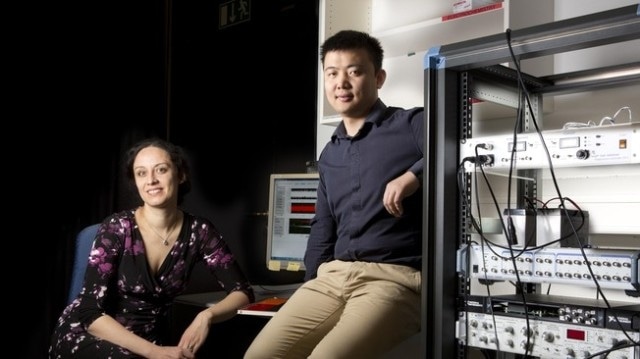Mar 29 2016
EPFL researchers have shown that a law of physics having to do with electron transport at nanoscale can also be analogously applied to the ion transport. This discovery provides insight into a key aspect of how ion channels function within our living cells.
 © Alban Kakulya/ 2016 EPFL
© Alban Kakulya/ 2016 EPFL
The membrane of all human cells contains tiny channels through which ions pass through at high speed. These ion channels play a fundamental role in how neurons, muscular cells and cardiac cells in particular function.
Ion channels are extremely complex, and many questions remain unanswered. How do the channels select the ions allowed to pass through? What accounts for the channels' high conductivity?
Researchers in EPFL's Laboratory of Nanoscale Biology, which is headed by Aleksandra Radenovic, have demonstrated that ion transport could be described by a law of physics called Coulomb blockade. This finding has been published in Nature Materials. Their observation could improve our understanding of how these channels work.
An island of ions
To carry out their tests, the researchers created an artificial ion channel by making a hole less than a nanometer in size in a two dimensional material molybdenum disulfide. Then they put this material into a device consisting of two electrodes together with ionic solution on each side. When they applied a voltage, they were able to measure variations in the current between the two chambers. In contrast to the conventional ion transport in larger nanopores (>1 nm), where the flow of ions never completely stops, they observed at low voltage energy gaps- strips without any current - which showed that the ions were held up in the nanopore until the applied voltage was high enough to facilitate their crossing from one side of the hole to the other one.
In order to interpret these energy gaps, the researchers carried out other tests, such as playing with the liquid's pH , which modulates the charge of the pore. pH-induced conductance oscillations were also found. All these measurements led to the same conclusion: the manner which the ions are transported can be explained in terms of Coulomb blockade, a law of physics commonly associated with electron transport in quantum dots.
Until now, the mechanism characterized by Coulomb blockade was observed in electronics, particularly in semiconductor particles called quantum dots that tightly confine either electrons or electron holes in all three spatial dimensions. These ‘islands' are only able to hold a certain number of electrons, before giving way to the newcomers. The experiment led by EPFL researchers showed that the same phenomenon was happening with ion transport, when there was a nanopore involved.
"A number of theorists had predicted that Coulomb blockade could also be applied to ion channels. We were glad to collaborate on this work with Prof. Massimiliano Di Ventra from University of California, San Diego," said Radenovic. "And we proved them right, by observing this phenomenon for the first time using our nanopores." Jiandong Feng, the lead author of the article added: "This observation provides a lot of information on how ions travel through the sub-nanometer sized nanopore, setting the stage for future explorations of mesoscopic ion transport."
Source: http://actu.epfl.ch/